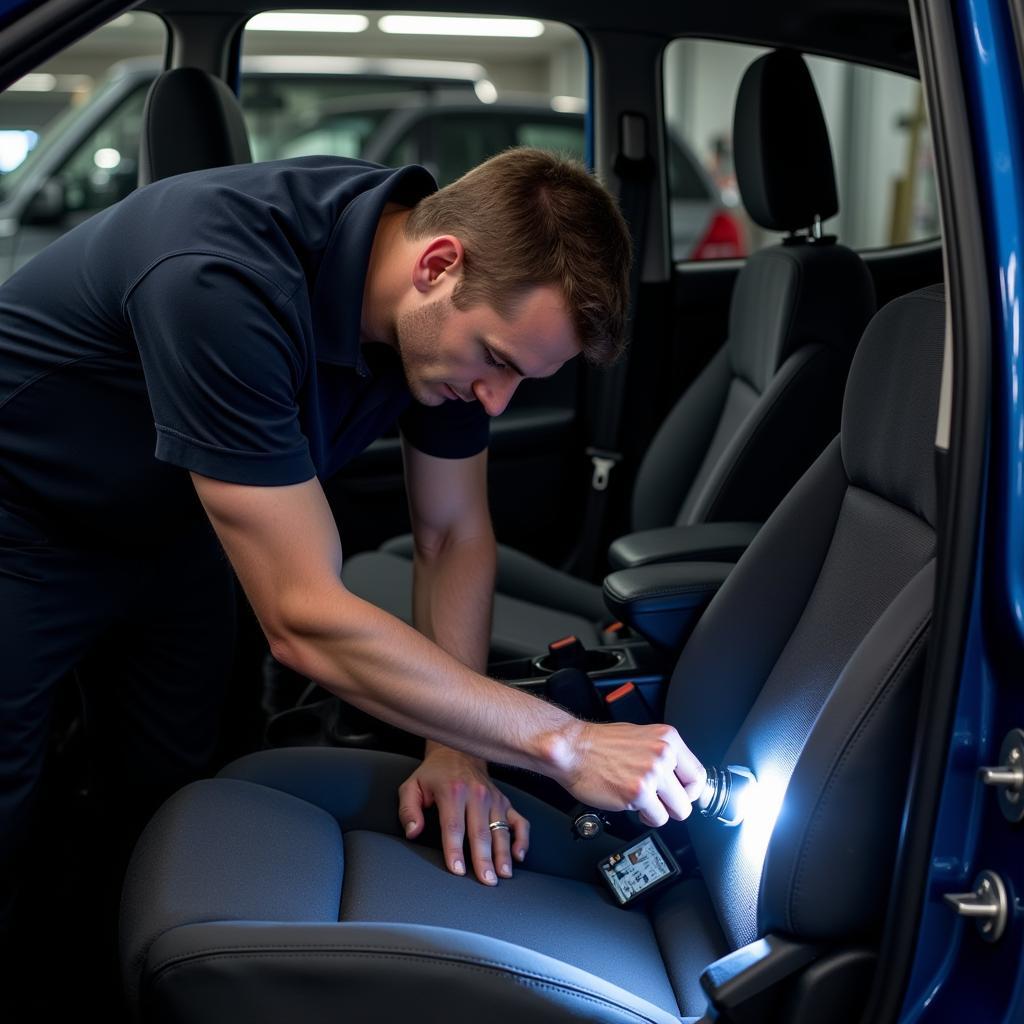The seat belt passenger warning light is a crucial safety feature in modern vehicles, designed to encourage seat belt use and keep everyone safe on the road. While its primary function is straightforward – to alert you when a passenger isn’t buckled up – the reasons behind a persistent or malfunctioning warning light can be diverse. This comprehensive guide delves into the common causes of a triggered seat belt warning light, offers troubleshooting tips, and provides potential solutions.
Understanding the Seat Belt Warning System
Before we delve into the causes and fixes, it’s crucial to understand how the system works. Most modern cars employ a weight sensor in the passenger seat to detect the presence of an occupant. When weight is detected, and the seat belt isn’t fastened, the system activates the warning light and often an audible chime.
Common Causes of a Seat Belt Passenger Warning Light
1. Unbuckled Seat Belt
This may seem obvious, but the most common reason for the warning light is simply that the passenger hasn’t fastened their seat belt. Always double-check that everyone in the vehicle is securely buckled up.
2. Faulty Seat Belt Buckle or Sensor
Over time, the seat belt buckle or the weight sensor within the seat can malfunction. A worn-out buckle might not latch properly, or a faulty sensor might not detect the passenger’s weight accurately, both triggering the warning light.
3. Damaged Wiring
The wiring connecting the seat belt buckle and sensor to the car’s electrical system can become damaged due to wear and tear, accidents, or even rodent interference. A break in the wiring can disrupt the signal flow, leading to a false warning light.
4. Software Glitch
Like any computer-based system, your car’s software can encounter glitches. A software error in the seat belt warning system can cause it to malfunction, leading to a persistent warning light even when everything else is functioning correctly.
5. Aftermarket Seat Covers or Modifications
Installing aftermarket seat covers, especially bulky ones, can interfere with the weight sensor’s ability to detect a passenger. Similarly, any modifications to the seat, like adding seat heaters, can disrupt the sensor’s operation, triggering the warning light.
 Passenger seat with seat belt warning light on
Passenger seat with seat belt warning light on
Troubleshooting a Seat Belt Passenger Warning Light
If you’re facing a persistent seat belt warning light, here’s a step-by-step troubleshooting guide:
- Check the Obvious: Ensure the passenger seat belt is properly fastened and that there are no objects placed on the seat.
- Inspect the Buckle: Examine the seat belt buckle for any visible damage or if it fails to latch securely.
- Check for Warning Light Patterns: Some cars use different warning light patterns to indicate specific issues. Consult your owner’s manual to decipher these patterns.
- Inspect the Wiring (If Comfortable): If you’re comfortable working with car electronics, visually inspect the wiring beneath the passenger seat for any damage or loose connections.
Fixing the Seat Belt Passenger Warning Light
While some fixes might be straightforward DIY tasks, others require professional attention:
- Fasten the Seat Belt: The simplest solution is often the most effective. Ensure the seat belt is properly clicked into the buckle.
- Replace the Buckle or Sensor: If the buckle is damaged or the sensor is faulty, replacement is often the most reliable solution. You can purchase these parts from a dealership or an auto parts store. Installation might require professional help.
- Repair Damaged Wiring: If you discover damaged wiring, it’s best to entrust the repair to a qualified mechanic to ensure it’s done safely and correctly.
- Software Update or Reset: A software glitch might require an update or a system reset, which a dealership or a specialized mechanic can perform.
 Mechanic inspecting a seat belt sensor in a car
Mechanic inspecting a seat belt sensor in a car
When to Seek Professional Help
While some fixes can be done at home, it’s always best to consult a qualified mechanic if:
- You’re uncomfortable working with car electronics or mechanics.
- The troubleshooting steps don’t resolve the issue.
- You suspect a software problem or damaged wiring.
- The warning light persists even after trying the DIY fixes.
Preventative Measures
- Regularly Inspect Your Seat Belts: Check for any signs of wear and tear, fraying, or damage to the buckle.
- Avoid Placing Heavy Objects on the Passenger Seat: This can put unnecessary strain on the sensor and lead to malfunctions.
- Be Mindful of Aftermarket Accessories: If you’re installing seat covers or other modifications, ensure they don’t interfere with the seat belt system.
how to turn off the seat belt warning chime mercedes
Expert Insight
“Many people underestimate the complexity of modern car safety systems,” says John Smith, a senior automotive electrician with over 20 years of experience. “The seat belt warning light, though seemingly simple, can be triggered by a range of issues from a loose connection to a software malfunction. It’s crucial to address the root cause and not just the symptom.”
Conclusion
The seat belt passenger warning light plays a vital role in passenger safety. Understanding its function and addressing any issues promptly ensures everyone in your vehicle is protected. While simple fixes might solve the problem, don’t hesitate to seek professional help when needed. Remember, safety on the road begins with a properly fastened seat belt.
FAQs
1. Can I disable the seat belt warning light?
While it’s technically possible to disable the warning light, it’s strongly discouraged. Disabling this safety feature compromises the safety of your passengers and might even be illegal in some areas.
2. Why does the warning light stay on even when no one is in the passenger seat?
This could indicate a fault with the weight sensor, a software glitch, or damaged wiring. It’s best to get your car checked by a professional.
3. Will using a seat belt extender affect the warning light?
Using a seat belt extender might interfere with the seat belt buckle’s ability to engage the sensor properly, potentially triggering the warning light.
4. My warning light is intermittent. What could be the problem?
Intermittent issues can be tricky. It might be a loose connection, a failing sensor, or even a software glitch. A professional diagnosis is recommended.
5. How much does it cost to fix a seat belt warning light issue?
The cost varies depending on the root cause. A simple buckle replacement might be inexpensive, while a complex wiring repair or sensor replacement can be pricier.


